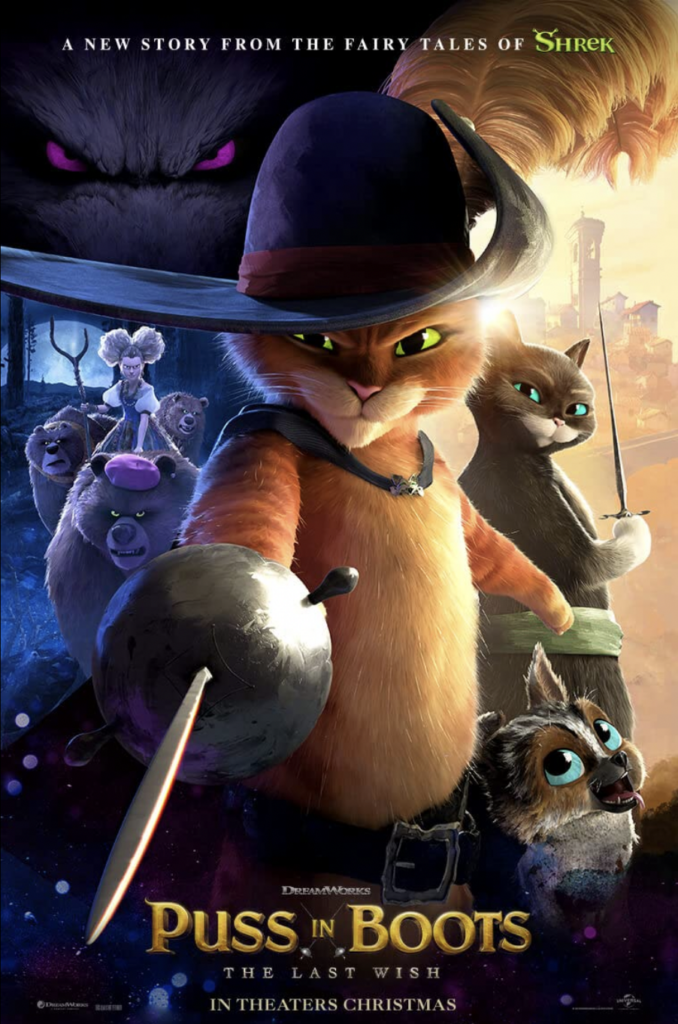After over twelve years since the original “Puss in Boots” hit the big screens, the long-awaited and highly acclaimed sequel has been accepted as a masterpiece. “Puss in Boots: The Last Wish” follows the story of the final life of Puss in Boots, the beloved feline who is desperate for one last wish, one he hopes is granted well.
To begin the film, the favorite fearless hero cat is smashed by a bell and is told he is on the last of his nine lives. Puss, at first, is unfazed, and it is of no concern to him. However, Puss is soon confronted by an ominous whistling wolf. He is frightened off and determines he must step down as Puss in Boots and become a house cat to survive. Soon enough, Puss has a reason to return to his legendary status, as Goldilocks and the Three Bears reveal that they are searching for the Magical Wishing Star, which grants any wish to anyone who possesses the map and finds the star. Puss realizes the Wishing Star is the way for him to evade death, so he joins the quest for the map.
Upon finding the map, Puss encounters Big Jack Horner, a villain after the star for magical greed, and Kitty Softpaws. Kitty is an old friend of Puss who has little trust left for him. Kitty and Puss—along with the addition of a homeless, strange dog referred to as Perrito—take off with the map. However, Big Jack, the bear family and the wolf are still always on their backs, waiting to overtake control of the Star.
The themes and internal values of “Puss in Boots: The Last Wish” are very uncommon for a typical animated children’s movie. It separates itself from other movies by providing an overarching, almost dark theme of not running from your death or your fears. Throughout the film, Puss is continually running from his fear of the wolf, and never confronts it. In the climax, he realizes that he should instead confront fear and live life to the fullest.
This latter theme is very well shown and is easy for kids and adults to understand. Perrito, the dog who tags along with Kitty and Puss, comes from a terrible background, and has never had any friends. However, he consistently finds joy in all he does. Perrito reflects the theme of living life to the fullest, as he is always seeking the positive and has a joyful time despite their circumstances.
With Perrito and Puss reflecting the major themes, it is easy to say that the character development of this movie was exceptional. Each character had their own story arc that grew and improved by the resolution, signifying the screenwriters’ abilities to emphasize each character trait. This is especially shown in Goldi and the Three Bears, as Goldi originally is seeking after the star to find a real, human family. However, as time goes on, she becomes closer to the three bears and realizes that her family is right in front of her. Additionally, Kitty Softpaws is a great embodiment of character development. She, at first, is lacking the ability to trust others, which hinders Kitty from believing anything that Puss or Perrito say. Kitty soon discerns that she could not trust anyone because she didn’t believe in herself. This realization allowed her to build relationships with others, an underlying theme director Joel Crawford was hinting at.
The directing of this movie is impeccable regarding the themes, along with the engaging visuals and ability to entertain. This animated movie has incredibly vibrant colors along with fascinating fight sequences that give a comicbook feel. The cinematography and animation create a sense of immersion into the plot and provide simple entertainment for all ages. Finally, the humor provided by Jack and Perrito serves kids and adults and creates a lively sense of emotion in the thick of action.
“Puss in Boots: The Last Wish” does a phenomenal job of combining important themes with a fast-paced, amusing plot. Its unique characters, mighty villain of death and wholesome humor for all ages combine for skilled execution in the telling of a fairy tale. Overall, it was able to provide one of the greatest animated movies ever, which is a wish well granted for all audiences.
